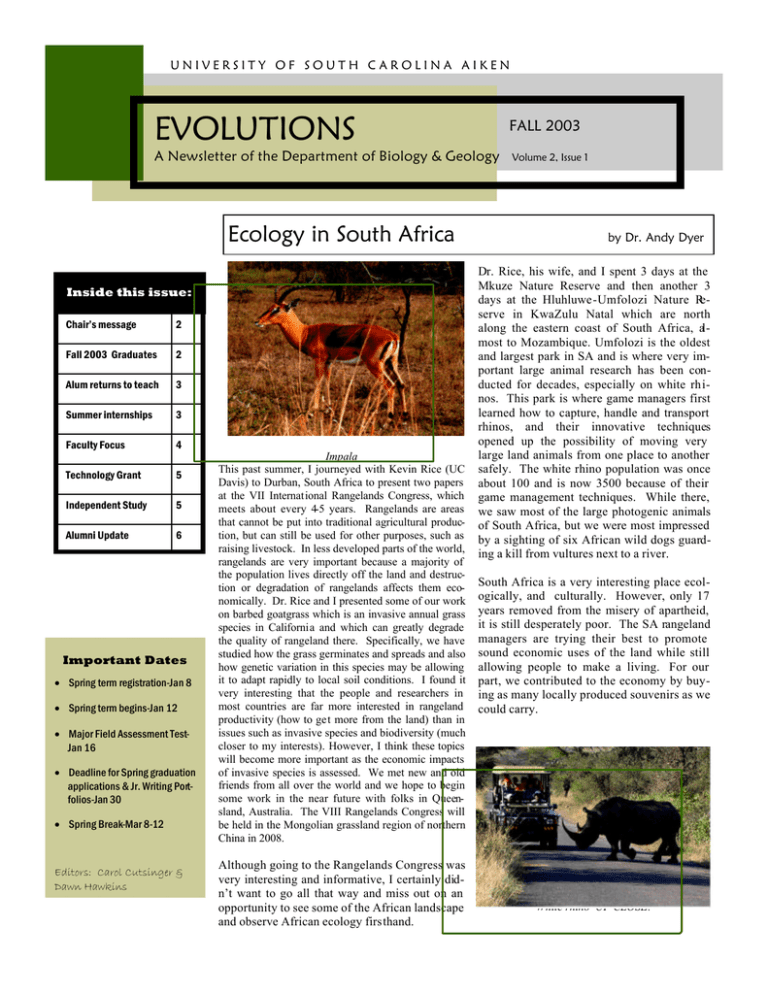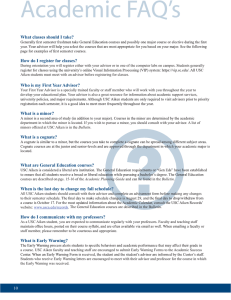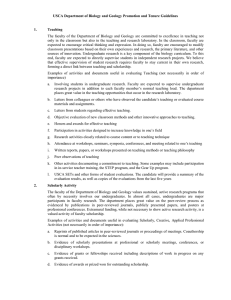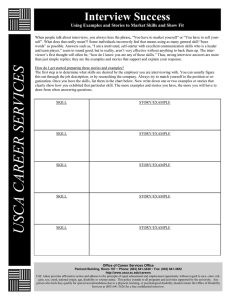EVOLUTIONS Ecology in South Africa FALL 2003
advertisement

UNIVERSITY OF SOUTH CAROLINA AIKEN EVOLUTIONS FALL 2003 A Newsletter of the Department of Biology & Geology Ecology in South Africa Inside this issue: Chair’s message 2 Fall 2003 Graduates 2 Alum returns to teach 3 Summer internships 3 Faculty Focus 4 Technology Grant 5 Independent Study 5 Alumni Update 6 Important Dates • Spring term registration-Jan 8 • Spring term begins-Jan 12 • Major Field Assessment TestJan 16 • Deadline for Spring graduation applications & Jr. Writing Portfolios-Jan 30 • Spring Break-Mar 8-12 Editors: Carol Cutsinger & Dawn Hawkins Impala This past summer, I journeyed with Kevin Rice (UC Davis) to Durban, South Africa to present two papers at the VII International Rangelands Congress, which meets about every 4-5 years. Rangelands are areas that cannot be put into traditional agricultural production, but can still be used for other purposes, such as raising livestock. In less developed parts of the world, rangelands are very important because a majority of the population lives directly off the land and destruction or degradation of rangelands affects them economically. Dr. Rice and I presented some of our work on barbed goatgrass which is an invasive annual grass species in California and which can greatly degrade the quality of rangeland there. Specifically, we have studied how the grass germinates and spreads and also how genetic variation in this species may be allowing it to adapt rapidly to local soil conditions. I found it very interesting that the people and researchers in most countries are far more interested in rangeland productivity (how to get more from the land) than in issues such as invasive species and biodiversity (much closer to my interests). However, I think these topics will become more important as the economic impacts of invasive species is assessed. We met new and old friends from all over the world and we hope to begin some work in the near future with folks in Queensland, Australia. The VIII Rangelands Congress will be held in the Mongolian grassland region of northern China in 2008. Although going to the Rangelands Congress was very interesting and informative, I certainly didn’t want to go all that way and miss out on an opportunity to see some of the African landscape and observe African ecology firsthand. Volume 2, Issue 1 by Dr. Andy Dyer Dr. Rice, his wife, and I spent 3 days at the Mkuze Nature Reserve and then another 3 days at the Hluhluwe-Umfolozi Nature Reserve in KwaZulu Natal which are north along the eastern coast of South Africa, almost to Mozambique. Umfolozi is the oldest and largest park in SA and is where very important large animal research has been conducted for decades, especially on white rhinos. This park is where game managers first learned how to capture, handle and transport rhinos, and their innovative techniques opened up the possibility of moving very large land animals from one place to another safely. The white rhino population was once about 100 and is now 3500 because of their game management techniques. While there, we saw most of the large photogenic animals of South Africa, but we were most impressed by a sighting of six African wild dogs guarding a kill from vultures next to a river. South Africa is a very interesting place ecologically, and culturally. However, only 17 years removed from the misery of apartheid, it is still desperately poor. The SA rangeland managers are trying their best to promote sound economic uses of the land while still allowing people to make a living. For our part, we contributed to the economy by buying as many locally produced souvenirs as we could carry. White rhino UP CLOSE! Page 2 EVOLUTIONS A Newsletter of the Department of Biology & Geology FALL 2003 From the Chair… Over the summer, we responded to an opportunity to be part of a statewide number of institutions committed to improving and enhancing biomedical research capacity and instruction in South Carolina. Six primarily undergraduate institutions were chosen to join USC-Columbia, Clemson, and MUSC in the effort, funded by the National Institutes of Health: College of Charleston, Winthrop, Furman, Wofford, Claflin, and Benedict were chosen, and we were not. However the department unanimously endorsed a long-range plan put forth in the proposal. At the request of the Chancellor, the Academic Council discussed this proposal and recommended pursuing its objectives. Salient features of the proposal included: 1) A departmental lab manager – The department lost a departmental lab manager position in January ‘99. The unit is serving at least the same number of students (in fewer sections) than ‘98-99. At the same time, faculty and Carol Cutsinger are responsible for ordering and preparation of their instructional lab materials and the supervision of the work-study students. More faculty are generating more external funding than in any time in the past. The unit needs to recover the lab manager position 2) An additional faculty member with a biomedical background - This responds to a strong student interest in this area of biology, and our record placing students in professional and graduate programs in science over the past five years 3) Startup packages for two new faculty that are competitive with our peers and allow our junior faculty and students to be successful - In the past the department has cobbled together the funds for new hires to build labs. These were in addition to mentored development of the research programs of two in-place assistant professors. Travel funds were budgeted for all targeted faculty to present results at professional meetings. This was weighed against an expectation that they would have significant external funding in the fourth year in the program. Our vision spoke to four of seven strategic priorities outlined in USCA’s Strategic Planning Steering Committee’s final report to the Chancellor, August 2003: Superior Faculty and Staff – We want to continue the development of junior faculty, and attract and compete for the best faculty who want to teach undergraduates. We want to enable the success of their careers at the outset, including travel to national meetings for them to present results and establish broader collaborative research. The addition of a departmental lab manager will allow better use of faculty time for instruction and scholarship Quality Facilities & Equipment that Support Institutional Mission – We are proud of the facilities and research infrastructure investments in the Department of Biology and Geology. The targeted investments we have made have resulted in increased grants, and increased opportunities for our students Excellent Academic & Co-Curricular Programs – We provide an excellent academic program in Biology. Our graduates Paul Sharpton are prepared for success in the careers that they seek. Our emphasis on undergraduate research at all stages of the curriculum adds value to formal class-work Dynamic Student-Centered Environment- The success of this department’s programs will be found in our graduates and their later achievements. If we continue to provide opportunities for our students to participate in academic activities outside of class we are preparing those students for success after graduation. We are excited about this plan for the future, and hope you are too. Please let me what you think! Best wishes to you in the new year! Allen J. Dennis Congratulations December Grads! The following students were awarded a Bachelor of Science Degree in Biology at the Convocation on December 11, 2003: Christopher Brooks Kendra Copper —also awarded a B.S. Secondary Education Anne Helena Jantti Kathryn Oswald—magna cum laude Amanda Pridgen Francis Ricchiuto Angela Santomauro Paul Sharpton Jonathan Thibado Page 3 Alum returns to teach Alumni who attended USCA between the years of 1983 and 1987 may remember the smiling face of Michele Harmon, who graduated with a B.S. in Biology in the Spring of 1987. This Fall, she returned to her alma mater as a part-time instructor, teaching two lab sections for both ABIO 101 and ABIO 102. The intervening years have been busy ones for Dr. Harmon. Her first position following graduation was as an Aquatic Toxicologist for Normandeau Associates, where she performed toxicity testing for clients located throughout the eastern United States. She was promoted to Laboratory Supervisor in 1989 and was accountable for all aspects of the daily operation of the Aquatic Toxicology Lab. From 1991-92 she served as Technical Editor at Normandeau providing support for the preparation of numerous internal and client-deliverable documents, including a multi-volume technical report that summarized the results of a six-year comprehensive biological monitoring study of a cooling reservoir on the U.S. Department of Energy’s Savannah River Site. From 1992 to 1997 Michele was employed as an Environmental Scientist with Halliburton NUS Environmental Corporation in Aiken. During this time she began graduate studies in Environmental Health Sciences at the University of South Carolina, where she earned a Master’s of Public Health degree in 1998 and a Ph.D. in 2003. From 1996 to 2003, she was a Profes- sional Intern conducting environmental research with the U.S. Department of Energy’s Savannah River Site. Her last project involved the transport, transformation, and toxicity of mercury in a constructed wetland environment. Michele grew up in North Augusta, but has lived in Aiken for the past 18 years. She says coming back to USCA feels like coming home. She remembers doing her Senior Research Project with Dr. Spooner on katydids and taking classes with Dr. Shealy and Dr. Hanlin. In addition to the labs she is teaching for our department, she is also teaching a graduate level Environmental Science class at the School of Public Health in Columbia and an anatomy and physiology class at Aiken Technical College. In the Spring, she will teach a lecture/lab section of ABIO 101 and two lab sections of ABIO 102 while she searches for a full-time teaching position. It is a great pleasure to have her among us as a faculty member! Joint USCA/SRS Undergraduate Research Program For the past three summers Dr. Bill Pirkle has directed a program funded by SCUREF (South Carolina Un iversities Research and Educ ation Foundation) which provides Summer Research Internships at From left to right: Bruce Pattison, Tim Pearson, Danielle Murfee, Psaras McGrier, Brian Nevius, James Young, Dr. Pirkle SRS for students at USC Aiken and South Carolina State University. The program’s objectives are to introduce students to active scientific research and the research environment at the Savannah River Site, and to increase the number of science students who graduate from USCA and SCSU and become enrolled in graduate programs. Each student works for two to three months during the summer on a project at SRS under the direction of an SRS Technical Mentor. The student also has a faculty advisor and is enrolled for undergraduate research credit the semester following the internship. A written report is approved by both the faculty advisor and the SRS Technical Mentor, with an oral report being presented at the end of the semester. Frequently, students also present their research at the South Carolina Academy of Science meeting in the Spring. The students receive a stipend for their work during the summer as well as a partial tuition scholarship in the fall. 2001 Participants were: Danielle Murfee, Chris Stoudemayer, Michelle Willia ms, and James Young. 2002 Participants were: Moboluwade Abe, Eric Doman, Benitra Johnson, Psaras McGrier, and James Young. James Young’s paper, “Project Enhancement and Restoration Utilizing Geographic Information Systems Software at the Savannah River Site,” was awarded Best Undergraduate Presentation in Earth/Geological Sciences at the 2003 SC Academy of Science Annual Meeting. He was mentored at SRS by Tracy McLane, with Bill Pirkle serving as his faculty advisor. 2003 Participants were: Thomas Brewer, Brian Nevius, Bruce Pattison, and Tim Pearson. This year’s interns will be presenting the results of their research at USCA on December 5, 2003, and all four will also do presentations at the SC Academy of Science Annual Meeting at the Co llege of Charleston in April, 2004. The program has received funding for the summer and fall of 2004. Interested students should contact Dr. Pirkle at BillP@usca.edu. Page 4 FALL 2003 EVOLUTIONS A Newsletter of the Department of Biology & Geology What Would WeDr. Do Garriet WithoutSmith Them? Faculty Focus: Dr. Garriet Smith has been teaching at USCA since 1981 after completing his Ph.D. in microbiology at Clemson University. His educational history includes a B.A. and M.A.T. in Biology from Winthrop University and an M.S. in soil microbiology from Clemson. He is also on the Graduate Faculty of the Marine Science Department at USC Columbia, an Associate Faculty member of the School of the Environment in Columbia, a Research Associate at the Belle W. Baruch Institute of Marine Biology and Coastal Research, and full faculty mentor at the Medical University of South Carolina. Dr. Smith's research interests are in bacterial and fungal interactions with marine plants and animals, marine microbial ecology, seagrass ecosystems, coral reef diseases, sea fan pathology, and microbial symbiosis. He teaches ABIO 330 - Microbiology, a course often taken by biology majors as well as being a required course for nursing majors; ABIO 206 - Genetics and Society, a course for non-majors; ABIO 325 - Plant Physiology; ABIO 580 - Ecology of the Bahamas, an upper level course taught at the Gerace Research Center in San Salvador, the Bahamas, as well as special topics classes in Marine Biology. Dr. Smith has been active in the Earthwatch organization since the 1980s. The mission of the Earthwatch Institute is to engage people worldwide in scientific field research and education to promote the understanding and action necessary for a sustainable environment. 50,000 members and supporters are spread across the US, Europe, Africa, Asia, and Australia and 3,500 members volunteer their time and skills to work with 120 research scientists each year on Earthwatch field research projects in over 50 countries all around the world. Dr. Smith's first Earthwatch project was entitled Underwater Meadows and was designed to study seagrass meadows. For the past 12 years he has led a mission on Bahamian Coral Reefs with Dr. Tom McGrath from Corning Community College in New York. More information on Earthwatch is available at http://www. earthwatch.org. Dr. Smith has been taking classes from USCA to San Salvador since 1985 to study marine ecology. It was known that bleaching was occurring in the coral reefs, and as more monitoring was done to investigate this phenomenon, more and more coral diseases were being discovered. The destruction of the coral reefs was becoming a much more serious and widespread problem. In 1996, Dr. Smith’s lab identified the fungus Aspergillus sydowii as the pathogen causing seafan disease. An important discovery at this time found this fungus in the dust blowing across the ocean from Africa. Samples were taken during dust storms, a process that is continually monitored by the National Oceanic & Atmospheric Administration (NOAA). Satellite images of these events can be viewed on NOAA’s website at http://www.noaa.gov. Other coral diseases which are being studied by Dr. Smith’s lab include white band disease, yellow band disease, and dark spot disease. In addition to the numerous undergraduate students who work in the lab during their tenure at USCA, Dr. Smith also supervises the work of several graduate students. Diego Gil and James Cervino, both Ph.D. students in Marine Biology on the Columbia campus, are working with Dr. Smith on bleaching and yellow band disease, respectively. Sean and Sara James Polson, both alumni of USCA, completed master’s degrees at Cle mson under Dr. Smith’s direction and are now pursuing Ph.D. degrees at the Medical University of South Carolina. Among Dr. Smith’s main collaborators is another USCA alum, Dr. Kim Ritchie, who completed a Ph.D. in Molecular Genetics at UNC-Chapel Hill and went on to post-docs at the Smithsonian in Panama and Scripps Institute of Oceanography. In January she will take up a position as Senior Scientist at the Mote Marine Lab in Sarasota, FL. Dr. Smith has been awarded numerous grants to support his work and is currently funded by the National Science Foundation and NOAA. He also has support as co-chair of the World Bank Coral Disease Study, a long-term study designed to assess coral health worldwide. In September of this year he was a delegate to the 2nd Bilateral Confe rence between Russia and the US on Aquatic & Marine Organism Health in Shepardstown, WV. He is widely published in his field and has been featured in two PBS Scientific American Frontiers programs hosted by Alan Alda, Dust Busters and Alien Invasion, as well as Coral Killers, on the National Geographic’s Animal Planet. In the Su mmer of 2004 he will co-chair a disease session of the International Society for Reef Studies with Dr. Ernesto Weil of the University of Puerto Rico in Okinawa, Japan. Page 5 Ubiquitous Campus Computing Computer use in biology and geology courses has never been greater due to an initiative called the Ubiquitous Campus Computing program. This grant, coauthored by several members of the Biology and Geology faculty, including Drs. Dennis, Dyer, Hanlin, and Jackson, was awarded in summer 2003 and provided the department with a wireless mobile labtop cart containing 30 computers, 20 loaner laptops for students enrolled in ABIO 499 and ABIO/AGLY 398 GIS and 598 Advanced GIS. Additional funds were obtained to purchase twelve GPS units for field courses such as herpetology and ecology. The overall goal of this program is to improve and enhance the use of computers and technology in academic instruction in the Department of Biology and Geology. The mobile laptop cart more than doubles the number of computers available to students enrolled in biology and geology courses. Corresponding to the arrival of the laptops this past fall was the initiation of wireless LAN and internet access in the Science building, which is a continuation of a campus-wide wireless initiative. With the wireless system online, laptop computers are no longer tied to a direct LAN connection to access email or the internet. In addition, the laptop cart is equipped with a laser printer that is accessed through the wireless system. This past fall, ABIO 101 courses taught by Drs. Jackson and Yates were the first to put the new technology to work. Said Jackson, “In the past 101 students were required to work in groups of four in the laboratory due to the limited number of computers available. The laptop cart allowed me to reduce each group size to two thereby increasing student opportunity to learn new technologies such as SigmaPlot, which is installed on each laptop”. Towards the end of the semester, students in Dr. Dyers Ecology and Evolution course also used the laptops to analyze data obtained in the laboratory. This spring several courses, including ABIO 101, 102, 355, and AGLY 398 GIS in the Sciences, are taking advantage of these new technologies. These technologies fit well with the mission of the Department to integrate established and emerging technologies into classroom instruction, to increase the appeal of the sciences to the non-major, and to better prepare majors for future careers. Fall 2003 Independent Research Projects Research continues to be an integral part of our department’s program . Students pursue independent study projects under the tutelage of faculty members, and those pursuing a B.S. degree are required to complete a senior research project. Listed below are projects for Fall 2003. Independent Study Projects Jacklyn Davis: Testing of Ribozyme in an RNA Pol 1 Cassette. Project advisor, Dr. William Jackson. Vanessa Guy: In vitro testing of ribozyme targeted to HIV-1 tat mRNA.. Project advisor, Dr. William Jackson. Carol Journey: Structural analysis of HIV-1 tat RNA. Project advisor, Dr. William Jackson. Marlon Smith: Environmental GeomorAmanda Pridgen: Nocturnal behavior of pholohy mapmaking techniques. Advisor, the African elephant. Advisor, Dr. Andy Professor Karin Willoughby. Dyer. Natalia Surzenko: DNA sequences of catalytic and non-catalytic hammerhead ribozymes. Advisor, Dr. William Jackson. Zane Prosser: Factors affecting seed recruitment in longleaf pine. Advisor, Dr. Harry Shealy. Bianca West: Design and cloning of antiHIV ribozymes. Advisor, Dr. William Jackson. Francis Ricchiuto: Mapping pKT230. Advisor, Dr. James Yates. Senior Research Projects Lauren Booth: Non-native terrestrial invasive plants in Hitchcock Woods. Advisor, Dr. Harry Shealy. Chris Brooks: Lethal temperature thresholds for chufa tubers. Advisor, Dr. Andy Dyer. Angela Santomauro: Transformation of LS2 cells: chemical methods. Advisor, Dr. James Yates. Paul Sharpton: PCR amplification of LB400 genomic DNA. Advisor, Dr. James Yates. Kayce Singletary: Introduction to cephal opod biology and mariculture. Advisor, Dr. Cory Hall: Disturbance and plant invasions Heather Bennett. Rebecca Napier: Design and cloning of in Hitchcock Woods. Advisor, Dr. Harry anti-HIV tat ribozymes. Advisor, Dr. Wil- Shealy. Melissa Cameron Storey: Octopus feedliam Jackson ing, mating, and development. Advisor, Pamela Johnson: Bacteria associated with Dr. Heather Bennett. Brian Nevius: Marine Pathogens. Project coral diseases in the Great Barrier Reef. advisor, Dr. Garriet Smith. Advisor, Dr. Garriet Smith. Stephanie Suarez: Transformation of LS2 cells: electroporation. Advisor, Dr. James Brian Sangid: Environmental vs. develKathryn Oswald: Determination of BerylYates. opmental readings. Advisor, Dr. Allen lium in ambient air. Advisor, Dr. Harry Dennis. Shealy. Jonathan Thibado: Sea Fan pathology. Advisor, Dr. Garriet Smith. Non-Profit Organization U.S.POSTAGE PAID Aiken, SC Permit #21 University of South Carolina Aiken EVOLUTIONS Department of Biology & Geology 471 University Parkway Aiken, South Carolina 29801 Address service requested We’re on the web! www.usca.edu/biogeo ALUMNI UPDATE We would love to include information in future issues about where our graduates are and what they are doing. Please take a moment to send this form to: EVOLUTIONS, Dept of Biology & Geology, USC Aiken, 471 University Parkway, Aiken, SC 29801, or e-mail the information to carolc@usca.edu. Name____________________________________________________ Year graduated_____________________ Current Address_______________________________________________________________________________ Current position or program of study_____________________________________________________________ What news would you like to share with USCA and other former students?____________________________ _____________________________________________________________________________________________ _____________________________________________________________________________________________ _____________________________________________________________________________________________ _____________________________________________________________________________________________ You can also update your information online at: http://www.usca.edu/alumni SEMINAR SERIES In an effort to improve our Friday Seminar Series, we hope to create an endowment that will allow us to enhance our current series. Attending the seminar series is a requirement for our Senior Research students, but the lectures are free and open to the public. The current schedule is available on our website at http://www.usca.edu/biogeo. Enclosed is my contribution of $_____________ (Please make checks payable to the Aiken Partnership with Biology Seminar Fund on the memo line). You can double your gift if you or your spouse is employed by a company having a “Matching Gift Program.” Please enclose your company’s matching gift form, available from your Human Resources Office. Send to: EVOLUTIONS, Dept of Biology & Geology, USC Aiken, 471 University Parkway, Aiken, SC 29801


